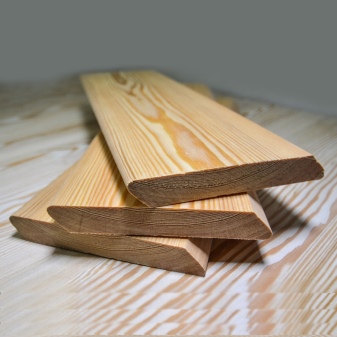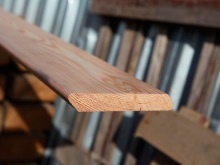All about beveled planken

Knowing everything about the beveled plank is very useful for the smart decoration of the house and other buildings. It is necessary to clearly imagine the installation of an oblique plank, the main options for fastening and methods of fastening to facade slopes. A separate topic is the use of beveled plank in the interior according to all the rules.

Peculiarities
The most important specificity of the beveled planken is high-quality grinding such boards. Thanks to the carefully machined edges, the installation process is extremely easy. This solution also makes it possible to significantly improve the decorative qualities. High-quality planken fully satisfies the needs of private house owners. In addition, this material is universal, it can be safely used both inside the house and on external walls.
In a beveled plank, the angle at the junction of the edge and face is approximately 45 degrees. This configuration - a parallelogram - is perfectly protected from moisture penetration into the cracks. This configuration also makes it possible to ensure that ventilation ducts and openings are masked. The outer surface will be seamless and will look as attractive as possible.
The total service life of the beveled planken is quite long, and damage to the material before the end of this period is practically excluded.


The boardwalk is in great demand larch material. It is extremely durable and reliable. To make this structure, use the hardest part of the barrel. Such a finish only becomes stronger after prolonged use. Larch planken is resistant to mold and other fungal influences, because the breed contains a lot of resins and gums.
There is no special need for antiseptic treatment, even in rather difficult conditions. However, it is still carried out in order to further increase the service life. Larch is very resistant to moisture and therefore is insured even in the event of a large amount of precipitation. This tree will be able to withstand fairly low temperatures. Finally, it will not be damaged even in bright sunlight.
Pine used relatively rarely. This material is appreciated only for its rather low cost. In terms of reliability, cedar is in a very good position. It resists mold and mildew very well.
Cedar planken is appropriate even for interior decoration of baths, which is facilitated by the healing effect of resin.


The cost of cedar material is not that great compared to conventional conifers. But such wood is formed by shortened fibers. This feature of the structure allows you to minimize cracking of the boards on the face and from the ends. The absence of resinous pockets also testifies in favor of the cedar. Such a tree can be safely used even in hot areas or in finishing the sunny side.
Planken production is not limited to simple shaving the board... She is necessarily exposed processing in a thermal chamber. Heat treatment involves exposure to a temperature of 160 degrees in combination with high humidity. This solution reduces the risk of warping and cracking.
In addition, the susceptibility to moisture absorption is reduced, and, of course, the risk of rotting.



What is it used for?
The description already given shows that the beveled plank can be used both as a facade material and in the interior of buildings.It looks appropriate not only in a residential building, but also in a fairly solid institution or organization. Excellent quality characteristics and resistance to adverse influences make it possible to safely use such material on the facade, even in places with a very harsh climate... Along with effective protection of the covered surface, the modern beveled plank will also provide a particularly cozy atmosphere in the house.
This material is often used to trim:
- gazebos;
- private baths and saunas;
- terraces;
- home fences;
- attached verandas;
- niches inside the house;
- repaired floors and stairs.



Categories
It is customary to distinguish several key digits of the oblique planken:
- grade "Extra" (there are no external deformations, the surface is absolutely perfect);
- variety "Prima" - with small knots, but a maximum of 1-2 pieces per 1 m2;
- grade AB - knots without specific consideration, the presence of resinous pockets and even knots falling out of the edge is allowed (provided that they overlap during assembly);
- grade BC is a particularly budget solution (an unlimited number of knots, pockets with resin, split areas to the edges, poorly planed zones, small cracks are allowed), while cyanosis cannot be allowed.



Dimensions (edit)
The length of the plank can vary from 2.5 to 6 m. The thickness of the boards is usually 15 to 25 mm. Moreover, their width varies from 70 to 140 mm. These are the standardized dimensions of the material that can be purchased from any supplier.
However, you can always order a product according to individual dimensions, taking into account all your needs.



Styling options
Vertical
Usage vertical plank for slopes and other structures - one of the modern European novelties. This approach has successfully survived severe competition with other design methods. It is on the vertical that the facade board is very often laid. It will look extremely impressive and will literally attract rapturous glances. This step is definitely for people who want to conduct a daring experiment using proven material.
Vertical planken finds more and more widespread use in the interior design of premises. The board laid in this way looks expressive. If you paint it also, you can achieve a literal "blossoming" of the texture. This solution will visually increase the height of the walls. Planken vertical laying will help to update the atmosphere and harmoniously fit even into a modern interior.
This finishing method is extremely reliable. The operation of the material is quite practical. But increased requirements for the quality of the structures used are necessarily applied. If during their manufacture key norms of the technological process were violated, problems are inevitable.
Therefore, it is necessary to buy products only from trusted suppliers with their own production.


Horizontal
The technique of horizontal planking is easy and therefore widespread. Such a solution is feasible even without special tools and great physical effort. If the angle bevel is 45-75 degrees, the material must be fastened in the same way as the shingles - from bottom to top. In any case, the planks must be separated by gaps of a certain size in order to avoid deformation of the assembly over time.
Natural wood cladding will "breathe", expanding with increasing humidity and decreasing as it dries, and the gaps compensate for this movement.


Diagonal
This approach to installing a wooden plank is more complicated than the previous two options, and is even considered a kind of art. Many masters achieve the formation of not only unique patterns, but also whole paintings. For this purpose, they combine blocks of different sizes and dissimilar shades. The installation itself is not too difficult, the main thing is to level the upper and lower edges of the boards.
Otherwise, no special special skills are required.

Mounting
The simplest way of fixing an oblique plank is recognized as fixing with decorative nails. In this version, there are 2 fasteners per 1 board - and the connection turns out to be as reliable as possible. Experts sometimes advise using vertical rows of nails, but other craftsmen disagree. The final choice of how to fix it is up to the owner. The preference for one approach or another affects only the decorative parameters, and the quality of the finish does not change.
Nails or screws (self-tapping screws) can be fixed with heads visible from the outside. In this case, they talk about an open installation method. Despite the worst aesthetic qualities, this method also has an attractive property - it simplifies repairs. With a closed fastening technique, special fasteners are needed. They are fixed to the inner surface of the plank, and the other edge is attached to the facade.

For your information: to obtain the planken itself, special cutters are often used in industries. Regardless of this, it is recommended to use Swedish brand screws for fastening it. Essve with unique type coating CorrSeal... A special anti-corrosion coating reliably prevents the formation of rusty streaks. The head of the screw is unobtrusive against the wood background, and the notches are designed so as not to unduly damage the material. The appearance of burrs, wood scoring is excluded.
An alternative solution is snake fixation. Professionals recommend laying the finishing board with an overlap, as already mentioned, but only the "snake" allows you to install beveled planks in a hidden way. A facade or terrace board is placed on such plates only along the logs. The width of the rails should be at least twice the width of the fasteners themselves. Boards are first laid out on a flat surface with the back side up.
Further carefully mark the places where the fasteners will be installed. It is attached to the intended positions. The extension of the ends of the plates beyond the contour of the board by at least 10 mm is required! Fasteners are placed wherever there is an intersection with the guiding parts of the lathing. The end of the fastening without a hole for the self-tapping screw must be brought under the previous board into the gap, the corner block is pre-assembled on the ground, tying the boards with a metal corner.

You can find out how to install a beveled plank on the facade of a house from the video below.












The comment was sent successfully.